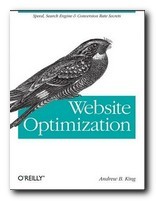speed, search engine, and conversion rate secrets
Andy King scored a big hit in 2003 with his first book Speed Up Your Site. It’s a guide which still has its own live web site where you can analyse the effectiveness of your web pages. His latest magnum opus Website Optimization goes way beyond that in scope and depth. It’s a guide to maximising every aspect of a website and its performance. It’s an amazingly practical manual, with page after page of ideas, suggestions, and strategies for getting your pages more widely known and read.
 On the whole, it’s not too technical, and he supplies snippets of code only when necessary. All the tips are within the grasp of anyone who is used to running a web site, and along the way he explains the principles of search engine optimization (SEO) as well as briefing you on how SEs treat your site. This is an up-to-date account of how search engines such as Yahoo and Google rank your pages and deal with search requests. He also presents real-life case studies in which he shows ‘before and after’ makeovers of professional sites. These are most instructive in that the ‘before’ pages look attractive and professional enough – until their underlying weaknesses are analysed and rectified. The improvements give what are claimed as up to fifty times more site visitors per day, and in the case of a cosmetic dentist the need to employ more staff and move to bigger offices in Philadelphia.
On the whole, it’s not too technical, and he supplies snippets of code only when necessary. All the tips are within the grasp of anyone who is used to running a web site, and along the way he explains the principles of search engine optimization (SEO) as well as briefing you on how SEs treat your site. This is an up-to-date account of how search engines such as Yahoo and Google rank your pages and deal with search requests. He also presents real-life case studies in which he shows ‘before and after’ makeovers of professional sites. These are most instructive in that the ‘before’ pages look attractive and professional enough – until their underlying weaknesses are analysed and rectified. The improvements give what are claimed as up to fifty times more site visitors per day, and in the case of a cosmetic dentist the need to employ more staff and move to bigger offices in Philadelphia.
The first half of the book deals with search engine marketing optimization, which can be expensive as one enters the world of paid advertising. But the second concentrates on things which anyone can do and afford – making pages smaller, lighter, and faster by trimming off the surplus fat. In an age of faster and faster broadband connections, web users are simply not prepared to wait more than a couple of seconds for a page to appear – so you’ve got to make important pages lean and speedy:
Web page optimization streamlines your content to maximise display speed. Fast display speed is the key to success with your website. It increases profits, decreases costs, and improves customer satisfaction (not to mention search engine rankings, accessibility, and maintainability).
All of these issues are dealt with in detail – and I particularly liked the fact that he was prepared to repeat some of the techniques when they occurred in different contexts. It’s not always easy to grasp some of these technologies in one simple pass. Especially as – in the case of optimizing images – he explains no less than sixteen possibilities for cutting file size and speeding up downloads.
He’s also keen on the optimization of style sheets and shows an amazing variety of techniques for creating what he calls ‘CSS Architecture’. Here too there are no less than ten strategies explained which offer cleaner, tighter, coding and the use of structural markup to beat browser peculiarities and rendering delays.
Most of his explanations are clearly articulated, but occasionally he lapses into less than elegant repetition and jargon, which could deter the inexperienced:
By converting old-style nonsemantic markup into semantic markup, you can more easily target noncontiguous elements with descendant selectors.
Fortunately, this sort of thing only happens occasionally.
There are some very nifty tricks for creating buttons and rollover techniques using style sheets, which saves the time to download a graphic files button, and thus once again speeds up page rendering.
He puts in two chapters on advanced web performance and optimizing JavaScipt and Ajax on your site which I have to admit went beyond my technical competence. But then it’s back to terra firma with understanding the metrics of your site’s performance – that is, knowing how to analyse the statistical data returned by website analysers such as Google’s Analytics and WebTrends.
I’ve never been able to understand before what page ‘bounce rate’ was until it was explained here – and I was astonished when I saw the results from some of my own pages!
As the search for more detailed information and for planning campaigns goes on – so the process becomes more like a science. There are graphs and formulae scattered around these pages to prove this. It’s the same for Pay Per Click advertising (PPC). All I can say is that if you are in this league, Andy King is your friend, and his advice is here thick on the ground to help you.
© Roy Johnson 2008
Andrew King, Website Optimization, Sebastopol, CA: O’Reilly, 2008, pp.367, ISBN: 0596515081
More on eCommerce
More on media
More on publishing
More on technology